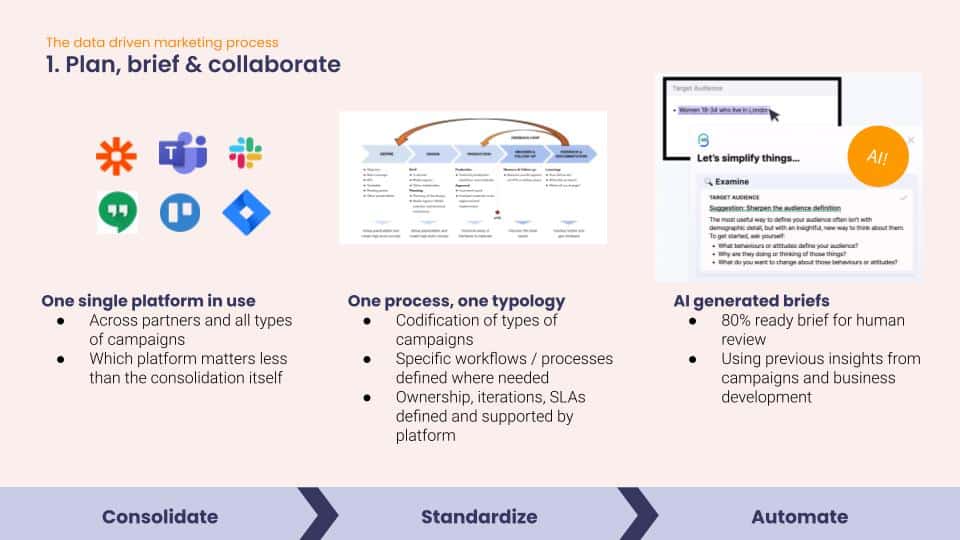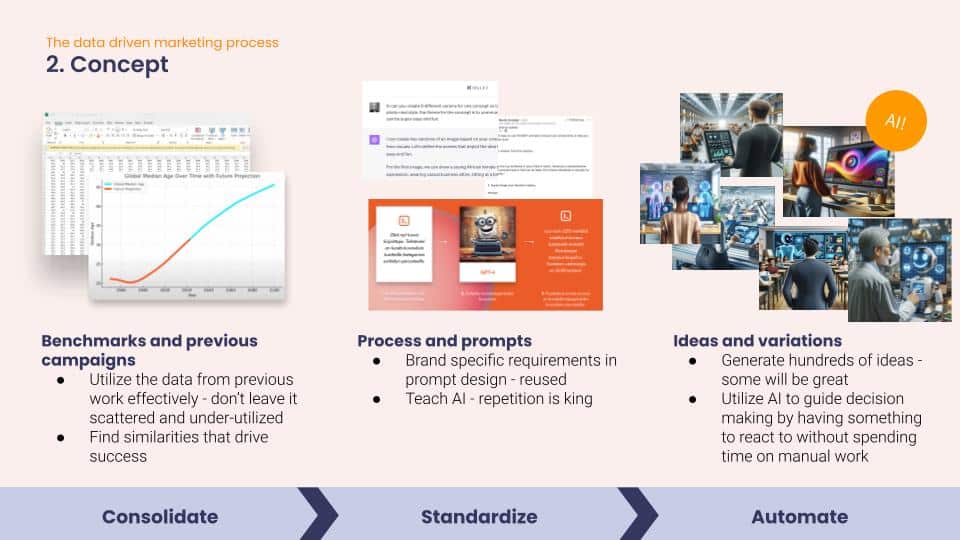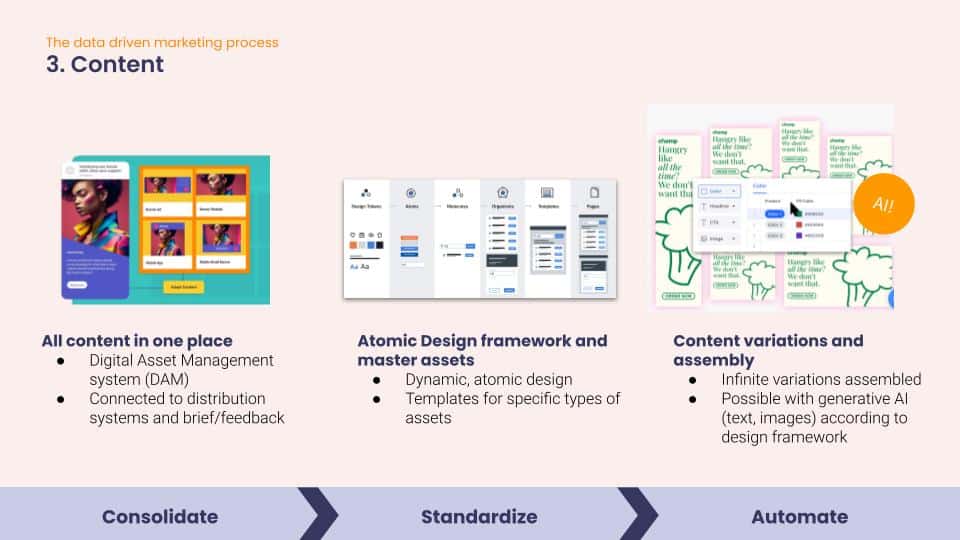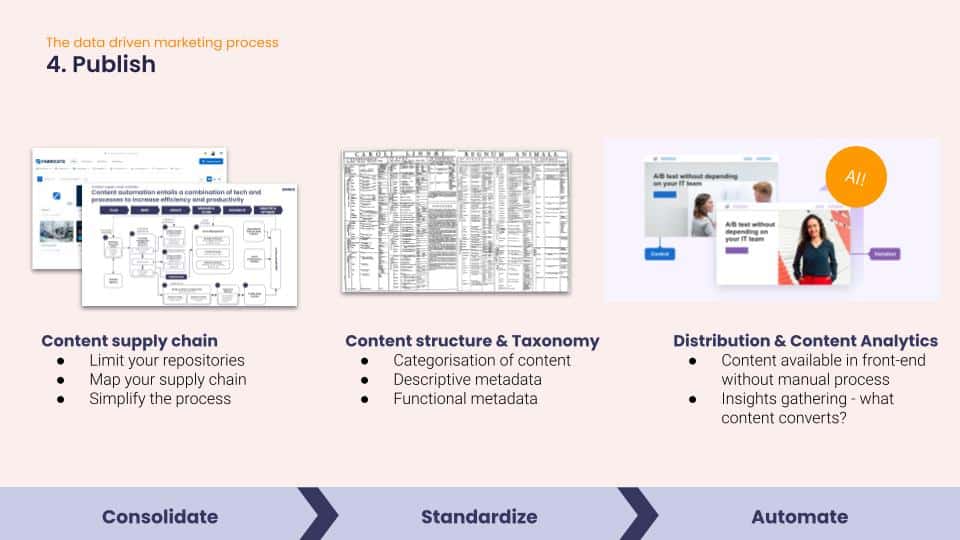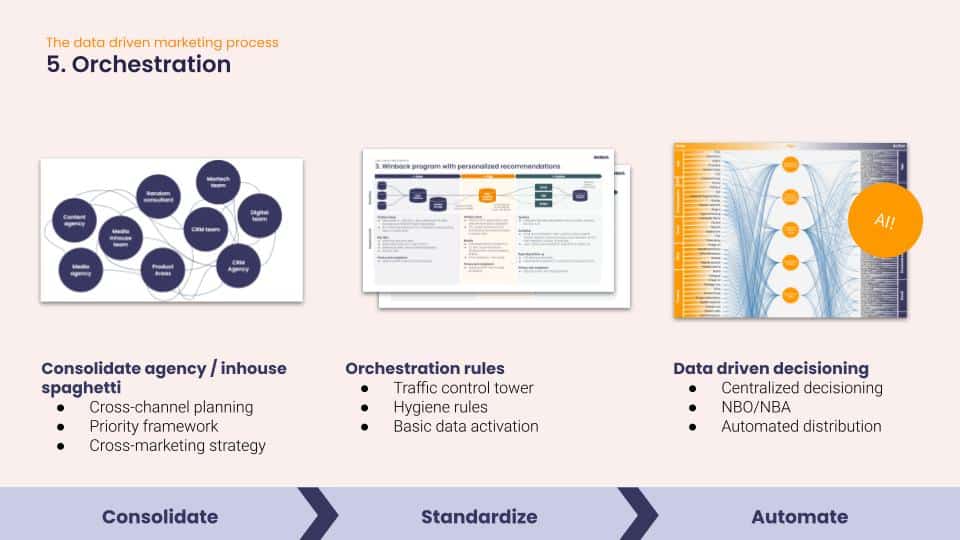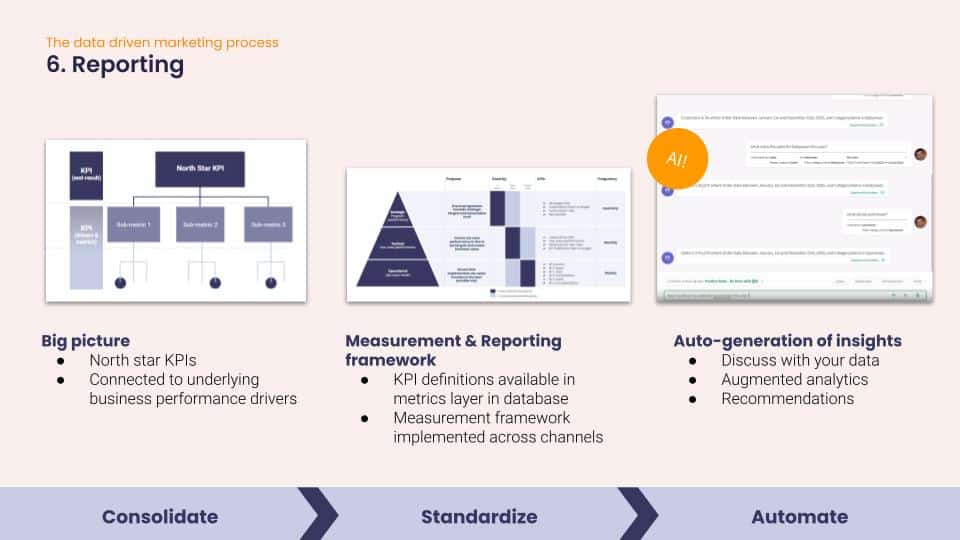The business world is not what it used to be, it is a world driven by data. What this means for you as a leader or professional in marketing, is that you are constantly looking for ways to make your work smarter, more efficient, and not to mention: personalized for your customers.
AI is stepping up to play a big role in achieving these goals, but the question is – are you keeping up with how AI is developing and the new possibilities within marketing and MarTech?
In this blog post, we aim to provide a simple guide on how to use AI for better productivity when it comes to marketing for mid-sized and bigger organizations.
Understanding the 6 productivity pockets in marketing
Let’s start with the basics. There are several areas in the marketing process where productivity can be improved significantly. These include 1) Plan, Brief & Collaborate, 2) Concept, 3) Content, 4) Publish, 5) Orchestration, and 6) Reporting. Each of these areas has different potential for productivity improvement, and the investment required also varies.
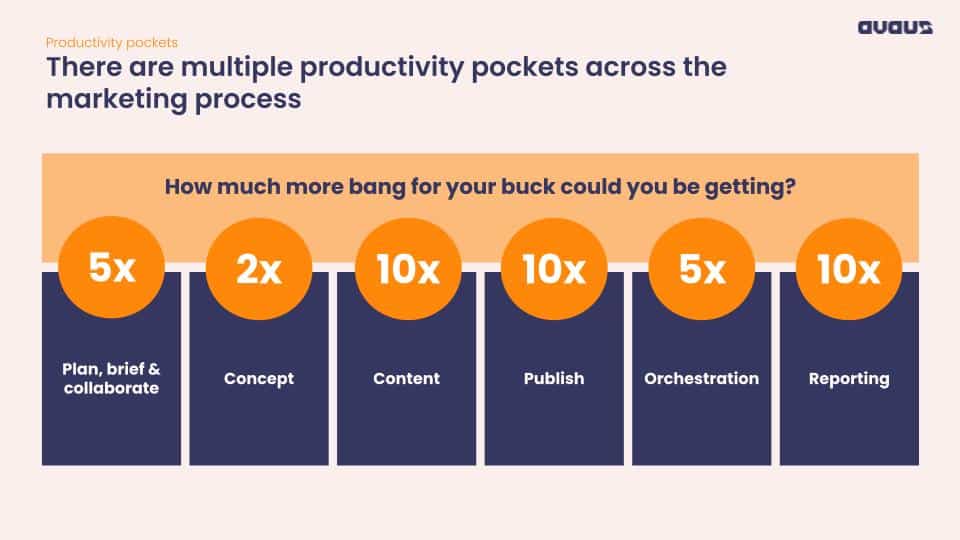
Here’s a deeper look into each of these productivity pockets:
1. Planning, briefing, and collaboration
Effective planning, briefing, and collaboration are critical for delivering consistent messages and preventing wasted efforts. Ensuring a unified strategy across marketing teams and partners is essential for achieving optimal productivity.
Typical pain points
- Fragmented collaboration tools
- Unclear business goals
- Unidentified roles and responsibilities
- Many stakeholders, many meetings
Solutions
- Standardized and automated briefing and feedback processes and workflows
- Data-driven insights for planning and optimization
- AI-generated briefs and notifications
- Create a testing and piloting culture
Productivity gains
- Faster turnaround from brief
- Less time in meetings
2. Concept
The concept phase encounters challenges such as time-consuming searches for benchmarks, a lack of understanding of past campaigns, and slow, siloed idea generation. Concepts often lack plans for personalization and scalability, coupled with a deficit in media understanding.
AI solutions provide a remedy, offering audience and results analysis, accelerating brainstorming, and refining visuals, storylines, copy, and messaging through AI testing. The key is a harmonious collaboration between AI capabilities and human expertise, resulting in quicker drafts, more time for value-driven tasks, and a substantial reduction in time wasted on mundane variations. This synergy optimizes efficiency and creativity in the marketing concept process.
Typical pain points
- Time-consuming to find relevant benchmarks
- Lack of understanding of previous campaigns
- Slow idea generation and conception phase in silos
- Concept not planned for personalization and scalability
- Lack of media understanding
Solutions
- AI-driven audience & results analysis
- AI-boosted brainstorming
- AI-crafted visuals & storylines
- AI-tested copy & messaging
- Use of human power where it adds the most value
- Work as one team
Productivity gains
- Quicker first drafts & more value-generation time
- Less time wasted on mundane tasks and variations
3. Content creation, storage and management
Creating marketing content can eat up time and resources. AI-powered tools can step in here, making content creation smoother, so your marketing team can focus on the cool stuff that really connects with your audience. Utilizing AI for content generation can not only free up human resources but also enable more impactful and personalized content.
Keeping digital assets in order is a headache for many marketing teams. A centralized Digital Asset Management (DAM) is the secret sauce. It tidies up your assets, making them easy to find and ensuring your brand’s style stays consistent.
Keeping your brand’s identity intact across various channels is a big deal. Dynamic design involves creating master assets and using AI to produce multiple variations for various audiences and languages.
Typical pain points
- Manual work → limited variations
- Lack of personalization & repurposing
- Compromised quality & no “wow” elements to differentiate from competition
- Slow assembly of elements
Solutions
- AI-powered creative optimization tools
- (Semi)Automated content assembly
- Content taxonomy & tagging
- Centralized content repository
Productivity gains
- No manual version control or down/uploads
- Ability to personalize without limits
4. Publish and distribute content
Spreading your content across different channels, and ensuring several touchpoints with your audience, is a marketing must. Siloed and manual distribution processes can lead to wasted time and resources. Centralizing decision-making with AI-driven models like next-best offers or next-best actions helps ensure cohesive, efficient content distribution.
Automated publishing, tagging, and Digital Asset Management (DAM) can also revolutionize this process, making content available in front-end without manual processes and facilitating in-flight optimization. The content supply chain can be simplified, and a content structure and taxonomy can be established, making the process more efficient.
Typical pain points
- Sending files manually
- Recreating the same campaign assets
- No testing for viewability
- Spending time searching for files
- Create once, never look back
Solutions
- Digital Asset Management (DAM)
- Automated tagging
- Automated publishing
Productivity gains
- Efficiency through automatization
- Effectiveness by in-flight optimization
- In-flight optimization possible
Read more about the content supply chain and content automation.
5. Orchestration
The orchestration phase often suffers from lazy targeting and paid media waste. There can be ad hoc or manual audiences, no use of 1st party data, poor customer experience (CX), and no machine learning capabilities for orchestration.
By consolidating agency/in-house processes, implementing centralized decisions, and setting up omnichannel audiences and data and content feeds, organizations can improve CX, make the orchestration process more efficient, and utilize automated distribution.
Typical pain points
- Lazy targeting & paid media waste
- Ad Hoc/Manual Audiences
- No first-party data used
- No/low personalization, poor CX
- No ML capabilities for orchestration
Solutions
- Centralized decisioning
- Omnichannel audiences
- Data and content feeds
Productivity gains
- Better CX drives conversion and results
- Higher automation level makes CX orchestration more efficient
6. Reporting and measurement
Understanding how well your marketing is doing is vital. A measurement framework and reporting system give you the insights you need to make smart decisions and shift from being a cost center to a profit center.
Typical pain points
- Ad hoc & Manual
- No standard reports
- No standard metrics / KPIs
- Too late to be meaningful
Solutions
- Control group strategy
- Data pipelines
- Attribution modelling
- Dashboards and Insight generation
- Metrics layer
Productivity gains
- On-time availability of reporting
- Time-efficient results review processes
- Actionable reporting & quicker decisions
How have others succeeded? 3 case examples
To wrap up this topic, let’s take a look at some cases from our clients in various industries. These are real examples of how they have improved their productivity.
Telco – A Telco company was able to increase its process productivity 3x by implementing a shared briefing and content viewing platform. This reduced the wasted time between all parties involved. Another Telco company achieved 5x media productivity by utilising first-party data and AI-driven optimization, reducing their media budget from 50m SEK to 10m SEK – with increased sales volumes.
Automotive – In the automotive industry, one company created a common working environment where all assets were stored, hosted, produced, and finalized in one depositary. This resulted in 5x efficiency.
Retail – A company in the retail sector managed to output 10x content assets with 50% of full-time employees (FTEs) by using automated assembly, an atomic design framework, and a technology-supported brief-to-approval process.
Get started with either a transformation or pilot approach
After identifying your productivity pockets and understanding how to optimize your marketing processes with AI, it’s time to put your plan into action. You can choose between a transformational approach, where you comprehensively revamp your marketing function or take a pilot approach for specific campaigns or initiatives.
In conclusion, AI is a powerful tool that can transform your marketing, sales, and service operations. By understanding the six productivity pockets within marketing and implementing AI-driven solutions, you can significantly enhance your productivity and ultimately achieve better results. Take the next step in your AI-driven marketing journey today!
Contact us to discuss your potential